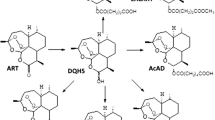Abstract
SCHISTOSOMES seem to depend primarily if not exclusively on the anabolism of preformed purines for their total purine nucleotide requirements (ref. 1 and our own unpublished observations). Among various purine analogues we tested against Schistosoma mansoni in vitro, tubercidin (7-deazaadeno-sine)2 was the most active, causing early separation of paired adults, alterations of the muscular activity pattern, and inhibition of egg laying in the medium when present in a concentration as low as 10−7 M. When administered to S. mansoni-infested mice either intraperitoneally or orally, tubercidin in effective dose regimens invariably caused 20–30% mortality. In an attempt to increase the margin of safety of this potentially useful antischistosomal agent, we considered the following facts in planning a new strategy of treatment. Schistosomes feed on blood cells, beginning about 2 weeks after cercarial penetration of the host3. Tubercidin is rapidly absorbed into red cells in vitro and is sequestered intracellularly in a phosphorylated form4. From 0.2–0.4 mg of tubercidin/ml. of whole blood can be so sequestered, and the longevity of tubercidin-containing red cells is unaffected4. We have investigated whether host red cells could deliver tubercidin to haematophagous forms of schistosomes, thereby increasing the selective toxicity of this antibiotic.
Similar content being viewed by others
References
Senft, A. W., Trans. NY Acad. Sci. (in the press).
Suzuki, S., and Marumo, S., J. Antibiot., Tokyo, 13 (1960).
Clegg, J. A., Exp. Parasitol., 16, 133 (1965).
Smith, C. G., Reineke, L. M., Burch, M. R., Shefner, A. M., and Muirhead, E. E., Cancer Res., 30, 69 (1970).
Riley, V., Proc. Soc. Exp. Biol. Med., 104, 751 (1960).
Pellegrino, J., and Katz, N., in Adv. Parasitol., 6 (edit. by Dawes, B.), 233 (Academic Press, New York, 1968).
Burwell, E. L., Brickley, B. A., and Finch, C. A., Amer. J. Physiol., 172, 718 (1953).
Grage, T. B., Rochlin, D. B., Weiss, A. J., and Wilson, W. L., Cancer Res., 30, 79 (1970).
Owen, S. P., and Smith, C. G., Cancer Chemother. Rep., 36, 19 (1964).
Author information
Authors and Affiliations
Rights and permissions
About this article
Cite this article
JAFFE, J., MEYMARIAN, E. & DOREMUS, H. Antischistosomal Action of Tubercidin administered after Absorption into Red Cells. Nature 230, 408–409 (1971). https://doi.org/10.1038/230408a0
Received:
Issue Date:
DOI: https://doi.org/10.1038/230408a0
- Springer Nature Limited
This article is cited by
-
Reactions with heterocyclic amidines (VI): Synthesis of some new sym. and assym. pyrazolotriazines and pyrazolo[4,5-e]pyrimidine derivatives
Archives of Pharmacal Research (1987)
-
?,?-Unsaturated nitriles in heterocyclic synthesis: Synthesis of some new pyrazolo[1,5-a]pyrimidine derivatives
Monatshefte f�r Chemie Chemical Monthly (1984)
-
Experimental chemotherapy of schistosomiasis mansoni
Zeitschrift f�r Parasitenkunde (1977)





